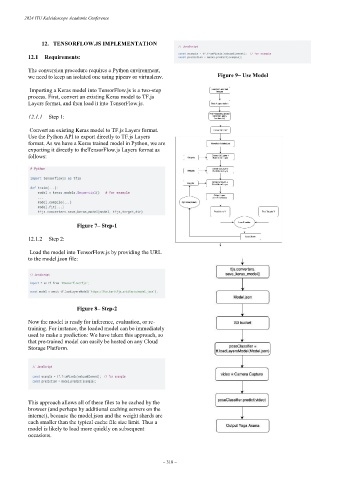Page 362 - Kaleidoscope Academic Conference Proceedings 2024
P. 362
2024 ITU Kaleidoscope Academic Conference
12. TENSORFLOW.JS IMPLEMENTATION
12.1 Requirements:
The conversion procedure requires a Python environment,
we need to keep an isolated one using pipenv or virtualenv. Figure 9– Use Model
Importing a Keras model into TensorFlow.js is a two-step
process. First, convert an existing Keras model to TF.js
Layers format, and then load it into TensorFlow.js.
12.1.1 Step 1:
Convert an existing Keras model to TF.js Layers format.
Use the Python API to export directly to TF.js Layers
format. As we have a Keras trained model in Python, we are
exporting it directly to theTensorFlow.js Layers format as
follows:
Figure 7– Step-1
12.1.2 Step 2:
Load the model into TensorFlow.js by providing the URL
to the model.json file:
Figure 8– Step-2
Now the model is ready for inference, evaluation, or re-
training. For instance, the loaded model can be immediately
used to make a prediction: We have taken this approach, so
that pre-trained model can easily be hosted on any Cloud
Storage Platform.
This approach allows all of these files to be cached by the
browser (and perhaps by additional caching servers on the
internet), because the model.json and the weight shards are
each smaller than the typical cache file size limit. Thus a
model is likely to load more quickly on subsequent
occasions.
– 318 –

